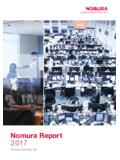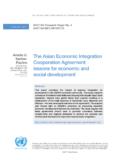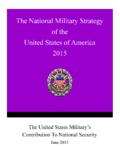Transcription of vision 2025 1 - Prime Minister of Sri Lanka
1 vision 2025 1vision 20252 vision 2025vision 20254 vision 2025vision 2025 5 The changing face of A DYNAMIC MODERN ECONOMY6 vision 2025vision 2025 7In January and August 2015, people of Sri Lanka exercised their franchise in a decisive manner, marking historic milestones in our country s journey. People in the north, south, east, west, and centre came together to vote for: a change in Sri Lanka s political culture against the politics of ethnic and religious division and against extremism on all sides; against impunity; for a strong democracy; for the rule of law and good governance; for reconciliation and sustainable peace; equality; upholding, promoting and protecting human rights of all and the pluralistic nature of our society; and for inclusive and equitable growth and development of the country.
2 These were the aspirations of the people of Sri Lanka who voted to send a message to those who they elected that the promise of strong democracy and democratic institutions, the promise of reconciliation and sustainable peace and the promise of development, must be fulfilled. Some of our promises have already been fulfilled. Chief among them are the restoration of Sri Lanka s image on the international stage, the 19th amendment to the constitution, the setting up of independent commissions, the Right to Information Act, the restoration of the freedom of expression, public consultations on the proposed reconciliation mechanisms and the constitution, the setting up of the constitutional assembly, measures to rid our nation of corruption and usher in a culture of good governance.
3 We have taken vital steps to reduce our debt burden, uplift the economic conditions of all citizens and ease the cost of living. Providing salary increments for state and non-state workers, increasing pension and Samurdhi payments, reducing the cost of essential items such as petrol, gas and medicine, were some measures taken by the Government to achieve the stated goals. Thus far more than 430,000 new jobs have been created in our efforts to create a million jobs. On others, we have initiated processes which are yet to reach fruition, but work continues with diligence. As in all democracies, progress is often not made in straight lines. Sri Lanka too, like all other countries in the world, is susceptible to the influence of global developments, natural disasters, and related challenges, and faces setbacks as a result.
4 However, as we now stand at the threshold of marking the 70th anniversary of independence of our nation, we are determined and firm in our resolve to work with constant, consistent effort and perseverance to ensure that we realise our dream of a stable, peaceful, reconciled, and prosperous Sri Lanka , for all people of our country, a dream that has eluded us for many years. This document sets out the path we are taking to make that dream a : 11 THE GOVERNMENT S ECONOMIC VISION04 PAGE: 16A NEW APPROACH TO GROWTH10 PAGE: 39 SOCIAL SAFETY NETS02 PAGE: 12 CONSTRAINTS TO GROWTH05 PAGE: 17 STRENGTHENING THE MACROECONOMIC FRAMEWORK11 PAGE: 41 AGRICULTURE AND SUSTAINABLE DEVELOPMENT03 PAGE: 13A 3-YEAR ECONOMIC DELIVERY PROGRAMME09 PAGE: 36 TECHNOLOGY AND DIGITALISATION07 PAGE: 25 REFORMS IN LAND, LABOUR AND CAPITAL MARKETS08 PAGE: 29 ECONOMIC AND SOCIAL INFRASTRUCTURE06 PAGE: 20 STRENGTHENING THE GROWTH FRAMEWORK12 PAGE: 48 GOVERNANCE AND ACCOUNTABILITY13 PAGE: 50 STRENGTHENING COORDINATION AND MONITORING IMPLEMENTATION14 PAGE: 51 CONCLUSION10 vision 2025vision 2025 1101.
5 THE GOVERNMENT S ECONOMIC VISIONOur vision is to make Sri Lanka a rich country by 2025. We will do so by transforming Sri Lanka into the hub of the Indian Ocean, with a knowledge-based, highly competitive, social-market economy. We will create an environment where all citizens have the opportunity to achieve higher incomes and better standards of living. To achieve this we must create the conditions which will generate economic growth with equity. The structural transformation necessary to achieve this vision is currently underway. The Empowered Sri Lanka document laid the foundation for this transformation by identifying the priorities of raising incomes, ensuring employment and housing for all, and improving the quality of life for all will position Sri Lanka as an export-oriented economic hub at the centre of the Indian Ocean.
6 We recognise the fundamental reality that Sri Lanka has a domestic market of only 20 million consumers with a modest per capita income, and must rely on external demand for sustained, high, and long-term growth. We will strategically position Sri Lanka as the hub of the Indian Ocean, securing opportunities for local businesses in global production networks (GPNs). This outward-looking approach will increase the efficiency of the domestic economy, contributing to a better life for all Sri Lankans. WE WILL STAMP OUTCORRUPTION BY ENCOURAGING COMPETITIONAND ENABLING TRANSPARENCY TO GIVE ALL SRI LANKANS AN EQUAL CHANCE AT PROSPERITYR eforms are necessary to enhance the productivity, efficiency, and global competitiveness of our economy. We face macroeconomic issues, particularly in public finance management, alongside structural considerations such as lack of product and market diversification, factor market constraints, weak property rights, inadequate infrastructure, inequitable access to finance, as well as institutional weaknesses and the existence of price distortions.
7 Economic growth has exhibited notable structural failings. Growth in recent years has primarily been through non-tradable activities driven by Government infrastructure spending based on heavy commercial borrowing. Persistent fiscal deficits and external current account deficits have resulted in poor investor confidence and low levels of foreign direct investment (FDI) and private domestic investment. Much of private investment, both local and foreign, has gone into real estate and related sectors as well as uncompetitive import substitutes. Export performance has been weak. The strong anti-export bias in the economy is a result of often uncompetitive exchange rates alongside high effective protection rates. Sri Lanka s exports are still concentrated on a few, mainly low-technology products.
8 The external sector has become heavily dependent on commercial borrowing, FDI inflows related to real estate development, and remittances from unskilled migration for foreign employment. Investment policies have failed to attract transformational, knowledge-based investments. Public finances have been a constraint on growth. A steady decline in Government revenue generation over time has resulted in a steady increase in public debt accumulation, particularly concentrated on high cost and high risk non-concessional foreign borrowing. High levels of public debt hamper growth through increased uncertainty, over-taxation, predominance of indirect over direct taxation, diverting resources from social and infrastructure development, excessive public sector borrowing resulting in crowding out of private investment and weakening resilience to shocks.
9 The fragile financial standing and the poor quality of public service delivery of state-owned enterprises (SOEs) are additional constraints to productivity and growth. Growth is also hampered by regulatory barriers. These barriers constrain both foreign and local private investment. Some of the most critical constraints are the dearth of land available for commercial and other productive purposes; the skill profile of the current workforce not being aligned with the needs of a globally-integrated economy; archaic labour laws and inefficiencies in the labour market that hinder female labour force participation; rigid border taxation laws which hamper trade facilitation, inadequate infrastructure in terms of access, quality and pricing of energy, transport and telecommunication; and access to finance, especially for Sri Lanka s small and medium enterprise (SME) CONSTRAINTS TO GROWTH12 vision 2025vision 2025 1303.
10 A 3-YEAR ECONOMIC DELIVERY PROGRAMMEOver the next three years, within the 2025 vision , we will implement a comprehensive economic strategy to address constraints to growth. We will aim to raise per capita income to USD 5,000 per year, create one million new jobs, increase FDI to USD 5 billion per year, and double exports to USD 20 billion per year. These intermediate targets lay the foundation for our vision 2025: Sri Lanka to become an upper-middle income vision 2025 Through a KNOWLEDGE BASED HIGHLY COMPETITIVE SOCIAL MARKET ECONOMYSri Lanka will becomeTHE HUB OF THE INDIAN OCEAN vision 2025 1516 vision 202504. A NEW APPROACH TO GROWTHOur new approach to growth will be structured on a knowledge-based, highly competitive, social market economy model.






